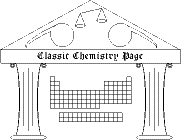Bodenstein kinetics
Max Bodenstein made detailed measurements of the thermodynamics and kinetics of the gas-phase decomposition of hydrogen iodide
2 HI < --- > H2 + I2 .
His work, published in 1899, was one of the first such investigations over an extended temperature range.
1) Bodenstein measured the rate constant for the decomposition of HI. Call this rate constant kd (for dissociation). Find the Arrhenius parameters (activation energy E and prefactor A) of this reaction.
| temperature (°C) | kd (arbitrary units)
|
| 508 | 0.1059
|
| 443 | 0.0067
|
| 427 | 0.0031
|
| 410 | 0.00137
|
| 393 | 0.000588
|
| 374 | 0.00023
|
| 356 | 0.0000809
|
| 302 | 0.00000326
|
| 283 | 0.000000942
|
(To download these data in a spreadsheet file, click here.)
2) Bodenstein also measured the rate constant kf for the formation of HI (i.e., for the reverse of the decomposition reaction). Find the Arrhenius parameters (activation energy E and prefactor A) of this reaction.
| temperature (°C) | kf (arbitrary units)
|
| 508 | 3.58
|
| 443 | 0.375
|
| 427 | 0.172
|
| 410 | 0.0659
|
| 393 | 0.0379
|
| 374 | 0.014
|
| 356 | 0.00676
|
| 326 | 0.00146
|
| 302 | 0.000353
|
| 283 | 0.0000826
|
(To download these data in a spreadsheet file, click here.)
3) The equilibrium constant Keq is related to the rate constants of forward and reverse reactions. That is, assuming that kd and kf were given in compatible units:
Keq = kd/kf .
Use the Arrhenius parameters and the temperature dependence of the equilibrium constant to estimate the standard molar enthalpy change ΔH and the entropy change ΔS for the decomposition of HI.
Reference
Max Bodenstein, "Gas reactions in chemical kinetics II. Effect of the temperature on the formation and decomposition of hydrogen iodide," Zeitschrift für physikalische Chemie 29, 295-314 (1899)
Copyright 2003 by Carmen Giunta. Permission is granted to reproduce for non-commercial educational purposes.

| Back to the top of the Classic Chemistry site |